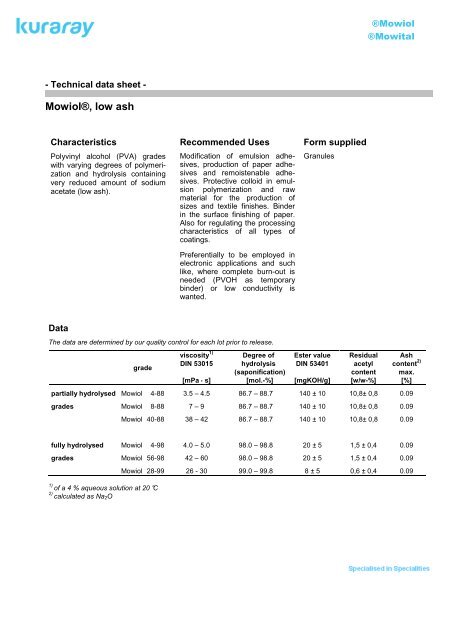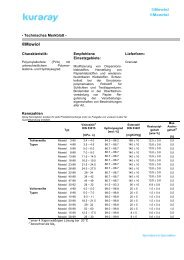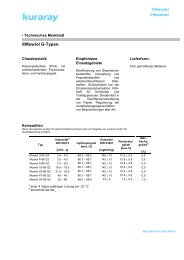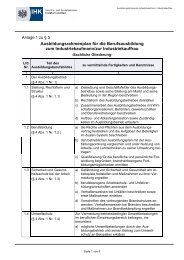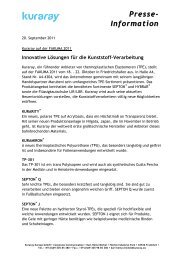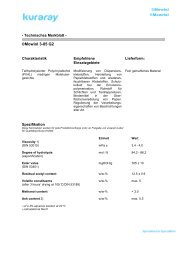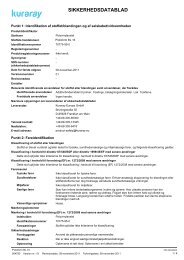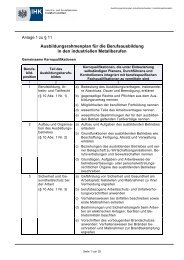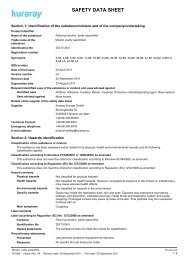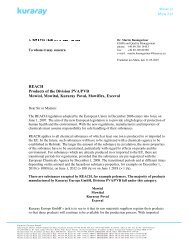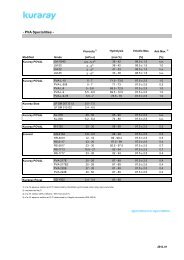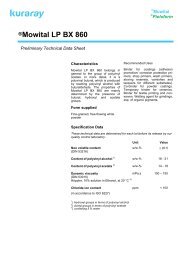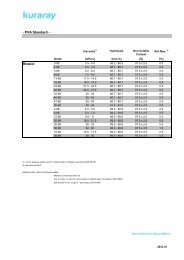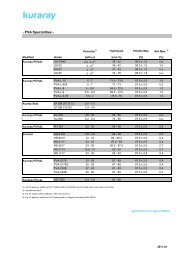Mowiol Low Ash - Kuraray Europe GmbH
Mowiol Low Ash - Kuraray Europe GmbH
Mowiol Low Ash - Kuraray Europe GmbH
You also want an ePaper? Increase the reach of your titles
YUMPU automatically turns print PDFs into web optimized ePapers that Google loves.
- Technical data sheet -<br />
<strong>Mowiol</strong>®, low ash<br />
Characteristics<br />
Polyvinyl alcohol (PVA) grades<br />
with varying degrees of polymerization<br />
and hydrolysis containing<br />
very reduced amount of sodium<br />
acetate (low ash).<br />
Data<br />
Recommended Uses<br />
Modification of emulsion adhesives,<br />
production of paper adhesives<br />
and remoistenable adhesives.<br />
Protective colloid in emulsion<br />
polymerization and raw<br />
material for the production of<br />
sizes and textile finishes. Binder<br />
in the surface finishing of paper.<br />
Also for regulating the processing<br />
characteristics of all types of<br />
coatings.<br />
Preferentially to be employed in<br />
electronic applications and such<br />
like, where complete burn-out is<br />
needed (PVOH as temporary<br />
binder) or low conductivity is<br />
wanted.<br />
The data are determined by our quality control for each lot prior to release.<br />
grade<br />
viscosity 1)<br />
DIN 53015<br />
[mPa ⋅ s]<br />
Degree of<br />
hydrolysis<br />
(saponification)<br />
[mol.-%]<br />
Form supplied<br />
Granules<br />
Ester value<br />
DIN 53401<br />
[mgKOH/g]<br />
Residual<br />
acetyl<br />
content<br />
[w/w-%]<br />
®<strong>Mowiol</strong> <strong>Mowiol</strong><br />
®Mowital<br />
Mowital<br />
<strong>Ash</strong><br />
content 2)<br />
max.<br />
[%]<br />
partially hydrolysed <strong>Mowiol</strong> 4-88 3.5 – 4.5 86.7 – 88.7 140 ± 10 10,8± 0,8 0.09<br />
grades <strong>Mowiol</strong> 8-88 7 – 9 86.7 – 88.7 140 ± 10 10,8± 0,8 0.09<br />
<strong>Mowiol</strong> 40-88 38 – 42 86.7 – 88.7 140 ± 10 10,8± 0,8 0.09<br />
fully hydrolysed <strong>Mowiol</strong> 4-98 4.0 – 5.0 98.0 – 98.8 20 ± 5 1,5 ± 0,4 0.09<br />
grades <strong>Mowiol</strong> 56-98 42 – 60 98.0 – 98.8 20 ± 5 1,5 ± 0,4 0.09<br />
1) of a 4 % aqueous solution at 20 °C<br />
2) calculated as Na2O<br />
<strong>Mowiol</strong> 28-99 26 - 30 99.0 – 99.8 8 ± 5 0,6 ± 0,4 0.09
Additional data, valid for all<br />
<strong>Mowiol</strong> grades<br />
Non-volatile content min. 95 %<br />
(after 3 hours drying at 105 °C/DIN<br />
ISO1625).<br />
Methanol content: less than 3 %.<br />
pH of a 4 % solution in distilled<br />
water (DIN 19261): 4.5 - 7 partially<br />
and fully hydrolysed grades.<br />
Bulk density (EN 543): approx.<br />
0.4 - 0.6 gcm -3 , depending on<br />
grade.<br />
The test methods for determining<br />
the data are fully described in our<br />
"Analytical chemistry <strong>Mowiol</strong>"<br />
brochure.<br />
The first number in the nomenclature<br />
denotes the viscosity of the<br />
4 % aqueous solution at 20 °C as<br />
a relative measure for the molar<br />
mass of the <strong>Mowiol</strong>; the second<br />
number denotes the degree of<br />
hydrolysis of the polyvinyl acetate<br />
from which the <strong>Mowiol</strong> grade is derived.<br />
There is a subdivision into<br />
"partially hydrolysed" and "fully<br />
hydrolysed" grades.<br />
Properties and uses<br />
Polyvinyl alcohols are watersoluble<br />
polymers manufactured by<br />
alcoholysis of polyvinyl acetate.<br />
The properties of the various<br />
grades are mainly governed by the<br />
molecular weight and the<br />
remaining content of acetyl groups.<br />
A distinction is drawn between<br />
partially hydrolysed and fully<br />
hydrolysed polyvinyl alcohols.<br />
Because PVAs have such good<br />
cohesion and good adhesion to<br />
fibres, fillers and pigments, all<br />
<strong>Mowiol</strong> grades are notable for their<br />
good bonding strength and<br />
pigment binding capacity. The<br />
latter intensifies with increasing<br />
molecular weight; in the case of<br />
<strong>Mowiol</strong> expressed by the viscosity<br />
of aqueous 4 % solution stated in<br />
the first number of the grade<br />
designation.<br />
This, together with the adhesive/<br />
cohesive strength and with a<br />
number of other specific properties,<br />
allows the manufacture of<br />
unfilled to highly filled systems for<br />
a variety of uses.<br />
Properties of <strong>Mowiol</strong> films<br />
The properties of <strong>Mowiol</strong> films are<br />
governed mainly by the grade of<br />
<strong>Mowiol</strong> used.<br />
The water resistance of dried<br />
<strong>Mowiol</strong>-based films increases with<br />
increasing molecular weight and<br />
degree of hydrolysis.<br />
It can be improved still further by<br />
heat-treating the dried film at a<br />
temperature of, for instance,<br />
120 °C. Another possible way of<br />
improving the water resistance of<br />
<strong>Mowiol</strong> films is to add acids such<br />
as orthophosphoric acid or salts<br />
such as ammonium chloride to the<br />
<strong>Mowiol</strong> solution in a quantity of<br />
5 % by weight, relative to <strong>Mowiol</strong>.<br />
Other products that can be used to<br />
increase the water resistance are<br />
aldehydes such as formaldehyde<br />
or glyoxal, and also ureaformaldehyde<br />
resins and<br />
melamine-formaldehyde resins in<br />
quantities of 10 - 20 % by weight,<br />
relative to <strong>Mowiol</strong>.<br />
Ultraviolet radiation on the dried<br />
<strong>Mowiol</strong> film also enhances water<br />
resistance.<br />
Plasticizers for <strong>Mowiol</strong> are<br />
polyhydric alcohols e.g. glycerol,<br />
neopentyl glycol, trimethylol propane,<br />
ethylene glycol, di- and triethylene<br />
glycol and polyethylene<br />
glycols up to a molecular weight of<br />
approximately 400 and in<br />
quantities of up to 30 % by weight,<br />
relative to <strong>Mowiol</strong>.<br />
<strong>Mowiol</strong> as an adhesive raw<br />
material<br />
<strong>Mowiol</strong> is used in a similar manner<br />
as natural products such as casein<br />
as well as starch and its degraded<br />
derivatives (for example dextrins)<br />
as raw material for the production<br />
of aqueous adhesive solutions.<br />
Compared to dextrins and casein<br />
<strong>Mowiol</strong> has the advantage of a<br />
more uniform chemical structure<br />
and greater adhesion, being<br />
obtained with minimum raw<br />
material requirements.<br />
Water-activated adhesives<br />
Remoistenable adhesives are employed<br />
mainly in the paper processing<br />
industry. Very familiar uses<br />
are the gumming of paper on the<br />
reverse side (e.g. postage stamps<br />
and labels) and the application of<br />
gum to the flaps of envelopes and<br />
Jiffy ® -type bags. Partially hydrolysed<br />
<strong>Mowiol</strong> grades with low to<br />
medium viscosity, e.g. <strong>Mowiol</strong> 4-88<br />
are particularly suitable for this<br />
function. To produce the adhesive,<br />
<strong>Mowiol</strong> solutions of up to 30 % are<br />
applied according to the viscosity<br />
requirements, these solutions<br />
containing additions of preservative<br />
and defoamer if necessary.<br />
The open time of the adhesive<br />
depends on the grade of <strong>Mowiol</strong><br />
employed. Increasing viscosity of a<br />
4 % <strong>Mowiol</strong> solution is generally<br />
accompanied by decreasing open<br />
time.<br />
An applied quantity of some 10 g<br />
<strong>Mowiol</strong> 4-88 solid per m² allows<br />
the production of coatings with<br />
very good remoistening properties<br />
and the following advantages:<br />
• high degree of flatness during<br />
storage under fluctuating air<br />
humidity<br />
• colourless, flexible coatings<br />
• minimal blocking tendency,<br />
even in high air humidity<br />
• fast setting after reactivation<br />
Wet bonding<br />
Higher-viscous and fully<br />
hydrolysed polymers such as<br />
<strong>Mowiol</strong> 28-99 and 56-98 are<br />
preferred if the adhesives are<br />
intended for the production of<br />
bonds resistant to cold water.<br />
These are used for such<br />
applications as the manufacture of<br />
special paper laminates (cardboard),<br />
spiral tubes and sealing
materials for packaging. Usually<br />
these <strong>Mowiol</strong> grades also possess<br />
higher "wet tack".<br />
Aqueous adhesives based on<br />
<strong>Mowiol</strong> can also be extended with<br />
fillers such as china clay. Even<br />
with ratios of approx. 2 parts by<br />
weight filler to 1 part by weight<br />
<strong>Mowiol</strong> it is still possible to obtain<br />
firm bonds in the winding of spiral<br />
tubes or the plane-surface bonding<br />
of paper and cardboard.<br />
Modification of emulsion<br />
adhesives<br />
Aqueous solutions of <strong>Mowiol</strong> can<br />
be added to polymer emulsions<br />
already stabilized with polyvinyl<br />
alcohol. This effects<br />
• extension of the open time<br />
• increase of the setting speed<br />
• influence on the rheology<br />
The open time is very important in<br />
such operations like the manual or<br />
machine bonding of wood and<br />
paper.<br />
In a number of polymer emulsions<br />
the addition of <strong>Mowiol</strong> solution<br />
increases the bonding speed<br />
considerably. Additions of up to<br />
10 % of an approx. 15 % solution<br />
of <strong>Mowiol</strong> to the polymer emulsion<br />
have proved to be suitable for this<br />
purpose.<br />
The choice of <strong>Mowiol</strong> grades is<br />
primarily dependent on the<br />
viscosity required in the ready-touse<br />
adhesive.<br />
Generally speaking, preference<br />
should be given to partially<br />
hydrolysed <strong>Mowiol</strong> grades on<br />
account of their faster solubility at<br />
lower temperatures.<br />
In emulsion adhesives suitable for<br />
application by dip wheel or roller<br />
on applicator machines the<br />
addition of <strong>Mowiol</strong> solutions has<br />
the advantage of largely<br />
preventing skin formation during<br />
processing.<br />
The combination of <strong>Mowiol</strong> grades<br />
with cellulose-stabilized polyvinyl<br />
acetate emulsions is also possible,<br />
but storage stability needs to be<br />
checked.<br />
<strong>Mowiol</strong> as protective colloid<br />
<strong>Mowiol</strong> grades, preferably of the<br />
partially hydrolysed range, are<br />
used as protective colloids in the<br />
polymerization of polymer<br />
emulsions. Because of their ability<br />
to anchor to the surface of the<br />
polymer particles that form, they<br />
help to stabilize the polymer<br />
emulsion during and after<br />
polymerization. Those <strong>Mowiol</strong><br />
types influence not only particle<br />
size distribution but also the<br />
application properties such as<br />
viscosity, stability to stirring, the<br />
freeze/thaw stability, pigment<br />
compatibility, electrolyte stability<br />
and open time of the emulsion.<br />
<strong>Mowiol</strong>, Binder in textile sizes<br />
The use of <strong>Mowiol</strong> as a binder in<br />
sizes is based on its good<br />
penetration capacity and good adhesion<br />
properties on all types of<br />
fibrous material. The excellent film<br />
characteristics of <strong>Mowiol</strong> like high<br />
cohesion and toughness, low<br />
electrostatic charging and<br />
redissolving capacity of the dried<br />
film in water complete the<br />
characterisation of this polymer as<br />
suitable agent for this purpose.<br />
<strong>Mowiol</strong> as a versatile auxiliary<br />
aid in paper applications<br />
Due to its broad property profile<br />
<strong>Mowiol</strong> is frequently used as a cobinder<br />
in paper coatings. The<br />
particular suitability of <strong>Mowiol</strong> in<br />
pigmented coatings is based on<br />
• its outstanding carrier properties<br />
to optical brightening<br />
agents<br />
• its excellent colloidal<br />
protection becoming effective<br />
in high solids pigment formulations<br />
which establishes a<br />
smooth viscosity profile<br />
• its good water retention in<br />
coating colours<br />
• its high binding strength in<br />
paper coatings which can be<br />
related to polymer cohesion as<br />
well as to good adhesion to<br />
the fibre and to the pigment<br />
particles, respectively<br />
<strong>Low</strong> molecular weight <strong>Mowiol</strong><br />
grades such as <strong>Mowiol</strong> 4-98 are<br />
the preferred polyvinyl alcohols to<br />
be used in paper coatings.<br />
<strong>Mowiol</strong> possesses remarkable<br />
barrier properties. Due to its<br />
insolubility in most organic solvents<br />
surfaces treated with <strong>Mowiol</strong><br />
repel hydrophobic products such<br />
as oil, grease and fat.<br />
Furthermore, <strong>Mowiol</strong> displays<br />
excellent mechanical strength<br />
properties if applied as a film on<br />
paper or paperboard. Therefore it<br />
fits well as a surface sizing agent.<br />
Many special paper grades are<br />
produced using <strong>Mowiol</strong>, such as<br />
• silicon base paper, to be used<br />
as release paper for PSA<br />
labels<br />
• banknote paper and grades<br />
with high folding endurance<br />
• thermoreactive paper for bar<br />
code labels or facsimile<br />
machines<br />
• film casting (release) paper<br />
• ink-jet paper<br />
Processing<br />
Preparation of <strong>Mowiol</strong> solutions<br />
In the adhesives sector <strong>Mowiol</strong> is<br />
processed as an aqueous solution,<br />
as it is in most other fields of<br />
application. The solution should be<br />
prepared in corrosion-resistant<br />
vessels.<br />
As a first step <strong>Mowiol</strong> is sprinkled<br />
into cold water during stirring and<br />
heated to 90 - 95 °C in a water<br />
bath or by the use of live steam.<br />
The solution should be stirred<br />
during cooling in order to prevent<br />
skin formation.
The partially hydrolysed <strong>Mowiol</strong><br />
grades dissolve in water much<br />
faster than the fully hydrolysed<br />
grades. The speed of dissolution<br />
increases with increasing<br />
temperature. For both partially and<br />
fully hydrolysed <strong>Mowiol</strong> grades the<br />
speed of dissolution decreases<br />
with increasing molecule size<br />
(increasing viscosity of the 4 %<br />
aqueous solution). The dissolving<br />
process is also made more difficult<br />
when there is a transition to higher<br />
concentrations. As a result even a<br />
more highly concentrated <strong>Mowiol</strong><br />
solution, e.g. a 30 % solution of<br />
<strong>Mowiol</strong> 4-88, should be produced<br />
at temperatures of 90 -95 °C.<br />
Polyvinyl alcohol solutions may<br />
produce foam when stirred or<br />
during transport in pipelines, but<br />
this can be largely prevented by<br />
using a suitable stirrer design such<br />
as a low-speed anchor stirrer or by<br />
avoiding steep downward<br />
gradients in the pipelines.<br />
Suitable defoamers are n-octanol,<br />
tributyl phosphate, Foamaster ®<br />
223 1) and the Agitan ® grades 2)<br />
301, 305 and 731, which are used<br />
in quantities of up to approx. 0.001<br />
- 0.010 % relative to the solution.<br />
Polyvinyl alcohol solutions which<br />
have been stored for lengthy<br />
periods may increase in viscosity.<br />
This is especially true of fully<br />
hydrolysed grades in high<br />
concentrations and at low<br />
temperatures. The original<br />
viscosity can be restored by<br />
heating and stirring.<br />
Preservation<br />
Like any other polyvinyl alcohol,<br />
<strong>Mowiol</strong> in the form of an aqueous<br />
solution can be attacked by microorganisms<br />
under certain<br />
conditions. In the acidic pH range<br />
the main organisms reproduced<br />
are the fission fungi, whilst bacteria<br />
grow most readily in a neutral to<br />
weakly alkaline medium.<br />
The solution can be preserved<br />
from any micro organism attack by<br />
adding a preservative. Products<br />
which have proved especially<br />
suitable for the purpose are for<br />
example the Mergal ® grades 3) K9N<br />
and K14. The dosage depends on<br />
the concentration of the solution,<br />
the storage temperature and the<br />
nature and intensity of the<br />
infection. Quantities of about<br />
0.01 - 0.2 % by weight<br />
preservative, relative to the <strong>Mowiol</strong><br />
solution, are generally sufficient.<br />
Compatibility and efficiency must<br />
be tested. Information on the<br />
quantity to be used is available<br />
from the suppliers.<br />
It is advisable for the <strong>Mowiol</strong><br />
solution to be prepared and stored<br />
in clean containers. Considering<br />
the resistance that may be shown<br />
by some micro-organisms to the<br />
preservatives employed, the<br />
dissolving vessel in particular, together<br />
with the filling equipment<br />
(pipes, valves, tubing etc.), needs<br />
to be kept clean. Any skins or<br />
incrustations should be removed.<br />
In the event of complications the<br />
possibility of changing to a<br />
different preservative must be<br />
considered.<br />
Certain applications for <strong>Mowiol</strong> in<br />
solution (cosmetic preparations,<br />
finger paints etc.) require the<br />
preservatives employed to be of<br />
approved types and physiologically<br />
inert. In such instances it is<br />
essential for the relevant legal<br />
regulations regarding physiological<br />
effects to be taken into account.<br />
Storage<br />
<strong>Mowiol</strong> can be stored for an<br />
unlimited period of time under<br />
appropriate conditions that is in its<br />
original packs in closed, dry<br />
rooms, at room temperature.<br />
This information is based on our present state of knowledge and is intended to provide general notes<br />
on our products and their uses. It should therefore not be construed as guaranteeing specific properties<br />
of the products described or their suitability for a particular application. Any existing industrial property<br />
rights must be observed. The quality of our products is subject to our General Conditions of Sale.<br />
® = Registered Trademark January 2010<br />
Industrial Safety and<br />
Environmental Protection<br />
Not classified as a dangerous<br />
substance or preparation according<br />
to the current criteria of<br />
chemical legislation, or of the EU<br />
Directives 67/548/EC.<br />
A safety data sheet is available on<br />
request.<br />
Special remarks<br />
Status as governed by<br />
foodstuffs legislation<br />
Refer to the <strong>Mowiol</strong> Brochure<br />
Regulatory information.<br />
1)<br />
Cognis Deutschland <strong>GmbH</strong>,<br />
Düsseldorf, Germany<br />
2)<br />
Münzing Chemie <strong>GmbH</strong>, Heilbronn,<br />
Germany<br />
3)<br />
Troy Chemie <strong>GmbH</strong>., Seelze,<br />
Germany<br />
<strong>Kuraray</strong> <strong>Europe</strong> <strong>GmbH</strong><br />
Division PVA-PVB<br />
______________________________________________ D-65926 Frankfurt am Main<br />
Contact details are available under<br />
www.kuraray-pva-pvb.eu


